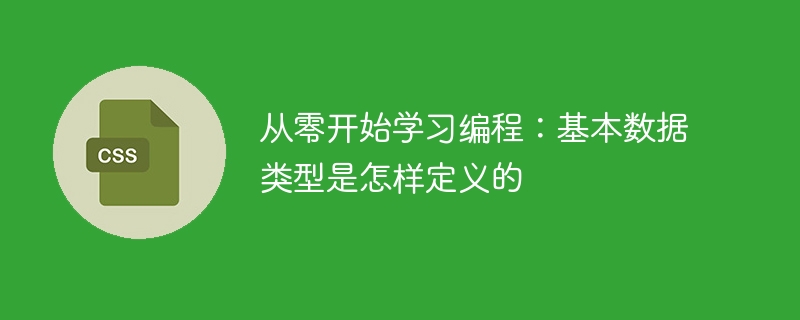Home >Web Front-end >CSS Tutorial >Learn Programming Basics: Explore the Definitions of Basic Data Types
Learn Programming Basics: Explore the Definitions of Basic Data Types
- WBOYWBOYWBOYWBOYWBOYWBOYWBOYWBOYWBOYWBOYWBOYWBOYWBOriginal
- 2024-02-18 15:16:061370browse

Learn programming from scratch: how basic data types are defined
Programming is a rapidly developing field, and mastering programming skills has become a part of modern society. important ability. For beginners, understanding the definitions of basic data types is the first step in learning programming. In this article, we will explore the definition and use of basic data types to help you learn programming from scratch.
In programming, basic data types are the most basic and simplest data types in programming languages, used to store a specific type of data. Different programming languages may define different basic data types, but common basic data types include integer, floating point, character and Boolean.
First, let’s discuss integer. The integer type is used to store integers, which can be positive, negative, or zero. Different programming languages may define integers of different sizes, such as 8-bit, 16-bit, 32-bit or 64-bit integers. Integers occupy a fixed size of space in memory and can perform basic arithmetic operations, such as addition, subtraction, multiplication, division, etc.
Then, let’s learn about floating-point. Floating point is used to store numbers with a decimal point. It includes single-precision floating-point numbers and double-precision floating-point numbers, which are used to store smaller and larger ranges of floating-point numbers respectively. Floating point numbers also occupy a fixed size of space in memory and support basic arithmetic operations.
Next, let’s discuss character. Character type is used to store single characters, such as letters, numbers, punctuation marks, etc. Different programming languages define different character encoding methods, such as ASCII code or Unicode. Character types occupy a fixed size of space in memory and can perform basic character operations, such as comparison, connection, etc.
Finally, let’s learn about boolean. The Boolean type is used to store logical values, that is, true or false. The Boolean type is mainly used in conditional judgments and logical operations, such as if statements, loops, etc. The Boolean type only takes up one byte of space in memory.
In the programming process, it is important to understand the definitions of basic data types because they determine the type and range of data you can store and process.
In addition to basic data types, some programming languages also provide composite data types, such as arrays, strings, structures, etc. These composite data types can organize and store multiple basic data types, making the program's data processing more flexible and efficient.
In actual programming, you can use variables to store and manipulate data. A variable is a name used to store a specific type of data, which can be assigned and modified. When declaring a variable, you need to specify the data type of the variable and allocate space for it.
The following is a sample code using basic data types:
# 声明一个整型变量 num = 10 print(num) # 声明一个浮点型变量 pi = 3.1415 print(pi) # 声明一个字符型变量 letter = 'A' print(letter) # 声明一个布尔型变量 isTrue = True print(isTrue)
Through the above example, you can see how to declare and use variables of different types.
In programming, the definition and use of basic data types are very basic knowledge points and are essential knowledge for beginners to get started. Once you master these basic concepts, you will be able to dive deeper into learning and understanding other advanced features of programming languages.
To sum up, basic data types are the most basic and simple data types in programming languages, used to store different types of data. Mastering the definition and use of basic data types is the first step in learning programming. I hope the content of this article can help you learn programming from scratch and lay the foundation for your programming journey.
The above is the detailed content of Learn Programming Basics: Explore the Definitions of Basic Data Types. For more information, please follow other related articles on the PHP Chinese website!

